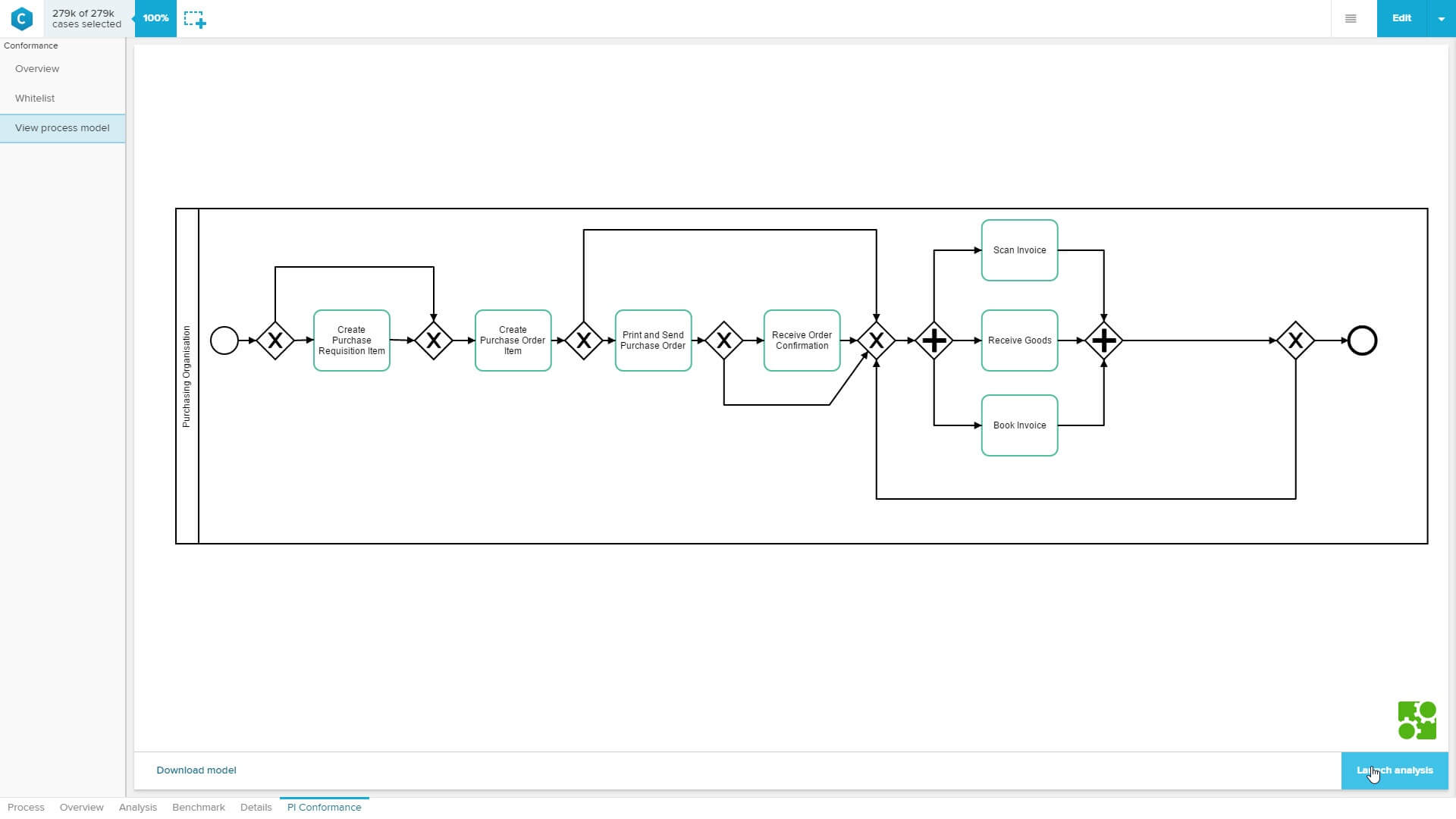From Data to Sustainability: A Greener Future with Process Mining

Essentially anything that happens within your company that has a clearly defined start and finish can be considered a business process. Do you remember the hassle you went through when applying for a job at your (dream) employer? You have been a part of an HR business process that began with your application and resulted in the on-boarding week! How about that invoice that your customer receives after he made a purchase with your company? This is your typical order-to-cash process.
Since each business process is unique, so will be its inputs that need to be fulfilled in (ideally) predefined and standardized scenarios and outputs that result in different goals. Factors that directly or indirectly contribute to your process can have a major impact on it and therefore should be pinpointed and inspected accordingly. For that we have a solution – Process Mining!
But before jumping in business Process Mining, let’s take a step back first.
To explain the meaning of the business process, you must dig quite a bit in the history. When you do that, you might discover a mention about a man named Adam Smith and his quote from year 1827 mentioned in his book “An Inquiry into the Nature and Causes of the Wealth of Nations”:
One man draws out the wire; another straights it; a third cuts it; a fourth points it; a fifth grinds it at the top for receiving the head; to make the head requires two or three distinct operations; to put it on is a peculiar business; to whiten the pins is another ... and the important business of making a pin is, in this manner, divided into about eighteen distinct operations, which, in some manufactories, are all performed by distinct hands, though in others the same man will sometimes perform two or three of them.
Fast forward into year 1993 and to the book “Process Innovation: Reengineering work through information technology” by Thomas Davenport
There you will read the following:
Business process is a structured, measured set of activities designed to produce a specific output for a particular customer or market. It implies a strong emphasis on how work is done within an organization, in contrast to a product focus’s emphasis on what. A process is thus a specific ordering of work activities across time and space, with a beginning and an end, and clearly defined inputs and outputs: a structure for action. ... Taking a process approach implies adopting the customer’s point of view. Processes are the structure by which an organization does what is necessary to produce value for its customers.
What to make out of these two (and numerous others) definitions? That the term of business process is very broad. Virtually any result-producing-action conducted by your organization is a business process. It doesn’t matter how big or small your company is or what it produces, however, it is safe to say that it reflects an established business process.
For your own convenience, we encapsulated all the essential components of a business process in 8 key components. For business process to be functional and sustainable, it must be in accordance with the following prerequisites:
In the next section, we will dissect the business processes into three major categories.
Due to the nature of the business processes, it is quite possible to break up them into couple of distinct types, some will be vital for your core business, others will support it.
Operational processes, also called the core business processes, are the activities that bring direct value to your company and your customers. Such processes are absolutely essential to your company and its perfection is crucial because they are generating your revenue.
Examples of operational processes:
To be able to only focus on core business, activities must be every business owner’s dream. As your organization grows, so do its business processes. In the real world, for every employee that focuses on core business and creates the value that consumers crave there are multiple workers that are not necessarily responsible for the final product but are helping to smooth the whole process. Without them, even the best organizations would collapse.
Examples of supporting processes:
Without these people and their respective processes, there is no future for any company.
Somebody needs to oversee how the company runs. The managers surely have their set of rules and processes which their follow.
Their main task is to measure, monitor and control all the business-related procedures and systems.
Examples of management processes:
To say that your organization should rely on a frictionless execution of the business processes would be an understatement. Each business process within an organization is a constantly evolving mechanism that dictates the future success of the company. Should you fail to acknowledge its importance, your competition might get an edge over you.
Hence, it should come as no surprise that organizations’ priorities should be constant improvements of their business processes to make them as efficient as possible.
A wise man once said:
If you can’t measure it, you can’t manage it.
The man was named Peter Drucker who laid down some of the essential foundations of the modern business corporation.
For every manager or executive to be informed and make fact-based decisions with the goal to improve the company’s internal procedures, the process performance needs to be measured. Since great share of all the business processes are either automatic or at least fully digital, it means one thing – the processes are producing a digital footprints and it is up to your organization to capitalize on the data you collect.
This is how you can make the best use of Process Mining techniques.
With Process Mining you can restructure your business’ computer-based processes and visualize them as-is sequences that reflect how well your business process performs and whether it conforms to the expectations.
At this point, there is a million subsequent topics to cover that are relevant for business processes. For starters, it would be a very good question how to optimize such processes and how to measure it against internal company benchmarks – that would lead you to KPI management.
Next big thing is a business process reengineering which is nothing more than redesigning your processes into easy-to-understand workflows.

Jakub Dvořák
Data Science Team Lead
Last, every business process owner is familiar with conformance checking. When you are checking whether the process conforms to your vision, you are essentially asking: “How much my process deviates from preferable scenario?” With Celonis conformance checking you can take Process Mining to the next level and create a fully integrated and automated target process comparison.
All these terms are extremely interesting and relate to rather deep topics, and, in our Processand blog, we will pay close attention to each of them in the near future, therefore, stay tuned!
Should you have any question regarding your business process and whether you should consider implementing it using the Process Mining techniques, do not hesitate to contact us through our form! Our data scientist will be pleased to answer you all questions.
Learn More About Process Mining.
Data processing
We use cookies to personalise content and ads, to provide social media features and to analyse our traffic. We also share information about your use of our site with our social media, advertising and analytics partners who may combine it with other information that you’ve provided to them or that they’ve collected from your use of their services. By clicking “Accept All Cookies” you agree that cookies are stored on your device, which assists us to help improve your website experience and help our marketing initiative. For additional information on how the cookies function, select the ”Manage Cookie Settings” or use the link here: Data Policy
Necessary
Necessary cookies help make a website usable by enabling basic functions like page navigation and access to secure areas of the website. The website cannot function properly without these cookies.
We use TYPO3 as a content management system (CMS). Cookies are used to store login information, for example.
We remember your data processing consent settings.
We use PHP to generate website content.
Analytics
Analytics cookies help website owners to understand how visitors interact with websites by collecting and reporting information anonymously.
We use Google Tag Manager to connect Google Analytics to our website.
We use Google Analytics to register a unique ID that is used to generate statistical data on how the visitor uses the website.